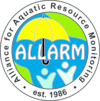

Program ended in 2017.
The shale gas drilling boom in Pennsylvania is filled with controversy. In order to apply some degree of science to the problem we as community scientists working on the health of our waterways became involved with Dickinson College's Alliance for Aquatic Resource Monitoring ( ALLARM).
Since shale gas drilling and hydraulic fracturing have the potential of allowing flow back water to reach streams and water supplies we needed a new approach for early detection. We partnered with the Alliance for Aquatic Resource Monitoring ( ALLARM) to accomplish our new goal of detecting flowback water from shale gas drilling and hydraulic fracking.
ALLARM is a project of the Environmental Studies Department of Dickinson College. Since its founding in 1986, ALLARM has become a nationally recognized technical and programmatic support center for community organizations interested in watershed assessment, protection and restoration.
ALLARM’s program goals are to:

Using ALLARM protocols monitoring now centers around testing for conductance and total dissolved solids on a weekly basis. Flow measurements and visual (observational) monitoring are also done.
The fracking fluid that returns to the surface during and after drilling is known to contain large amounts of chlorides, sodium, sulfates, metals (such as barium, iron, manganese, arsenic, strontium, lead, cadmium, chromium and aluminum), naturally occurring radioactive materials (such as uranium, radium, and radon), methane and bacteria.
Testing for each of these substances is expensive and time consuming. A simple way to determin if flowback water is entering a stream is to test water's conductivity and total dissolved solids (TDS). If those values are elevated then that is a sign that something abnormal is in the water and it should be tested further.
After baseline values have been established an increase of three times normal conductivity could be an indicator of flowback contamination. In such instances DEP is notified and a water sample is sent to a certified laboratory to be tested for barium and strontium. A positive test for barium and strontium is proof that flowback contamination is occurring.
Visual monitoring also provides information about other conditions that might be impacting stream health. Some examples are erosion and sedimentation, fuel leaks, chemical leaks and physical damage to roads. When visual monitoring detects a problem photographs are taken and a description of the problem is written. The information is then reported to the Conservation District and other appropriate authority.
Stream Monitoring
Site Map
The map shows the locations of unconventional gas wells and monitoring sites.
Clicking on the star icon will give you a link to the most up to date data.
This program ended in 2017
These are from Trout Unlimited
Using the Lamotte Tracer PocketTester
How to collect water quality data in the field
How to collect Quality Assurance / Quality Control Samples